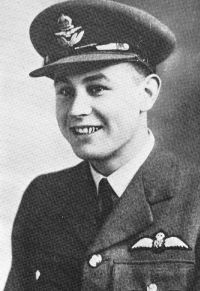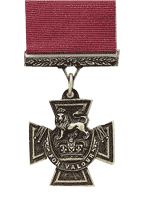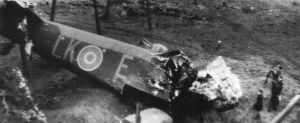
 |


On the night of 30th March 1944 Pilot Officer Cyril Barton became the only Halifax crewman to be awarded the countries top honour for gallantry. The victoria Cross. Here is a transcript of the announcement of his award in the London Gazette. A full and authorised Biography of the life of Cyril Barton and the fateful last flight of his crew can be found in the Squadron Book "Based at Burn MkII"
Information reproduced from the original announcement in The London Gazette.
Cyril Joe Barton (168669) VC R.A.F.V.R
Cyril Joe Barton entered pilot training the USA under the Arnold Scheme in late 1941. A member of Class 42G he set sail from Gourock, Scotland to Halifax, Canada aboard the transport ship "Pasteur". After acclimatization at Maxwell Field, Montgomery, Alabama he received his Primary Training at Darr Aero Tech, Albany, Georgia, and was one of a relative minority who were allowed to complete their training, having been "held back" by illness or accidents, finally graduating as a member of Class 42J.
The following citation appeared in the fifth supplement to The London Gazette of Friday 23rd June 1944, which was published on Tuesday 27th June 1944.
1.On the night of 30th March 1944, Pilot Officer Barton was captain and pilot of a Halifax aircraft of 578 Squadron detailed to attack Nuremberg. When some 70 miles short of the target, the aircraft was attacked by a Junkers 88. The first burst of fire from the enemy aircraft made the intercommunication system useless. One engine was damaged when a Messerschmitt 210 joined the fight. The bomber's machine guns were unable to return the fire.
2.Fighters continued to attack the aircraft as it approached the target area and, in the confusion caused by the failure of the intercommunication system at the height of battle, a signal was misinterpreted and the navigator, air bomber and wireless operator left the aircraft by parachute.
3.Pilot Officer Barton faced a situation of dire peril. His aircraft was damaged, his navigational team had gone, and he could not communicate with the remainder of the crew. If he continued his mission, he would be at the mercy of hostile fighters when silhouetted against the fires in the target area and if he survived, he would have to make a 4½ hours journey home on three engines across heavily defended territory. Determined to press home his attack at all costs, he flew on and, reaching the target, released the bombs himself.
4. As Pilot Officer Barton turned for home the propeller of the damaged engine, which was vibrating badly, flew off. It was discovered that two of the petrol tanks had suffered damage and were leaking. Pilot Officer Barton held to his course and, without navigational aids and in spite of strong head winds, successfully avoided the most dangerous defence areas on his route. Eventually he crossed the English coast only 90 miles north of his base.
5. By this time the petrol supply was nearly exhausted. Before a suitable landing place could be found, the port engines stopped. The aircraft was now too low to be abandoned successfully. Pilot Officer Barton therefore ordered the three remaining members of his crew to take up their crash positions. Then, with only one engine working, he made a gallant attempt to land clear of the houses over which he was flying. The aircraft finally crashed and Pilot Officer Barton lost his life, but his three comrades survived.
6.Pilot Officer Barton had previously taken part in 4 attacks on Berlin and 14 other operational missions. On one of these, two members of his crew were wounded during a determined effort to locate the target despite appalling weather conditions. In gallantly completing his last mission in the face of almost impossible odds, this officer displayed unsurpassed courage and devotion to duty.
Footnote: Aircraft as badly damaged as this one was, often faced "friendly fire" as they approached and crossed the coast to make for a suitable landing ground. Some would be hit by Anti-Aircraft fire; some would crash in sight of safety; whilst others had to face encountering clusters of barrage balloons and/or RAF night-fighter aircraft.
Cyril Joe Barton is buried at Kingston-on-Thames (C.W.G.C. Ref. UK4253) and is survived by his three sisters.

LK-E had the artwork of King Arthurs "Excalibur" chalked on the nose at the time of the crash

The wrecked rear fuselage at Ryehope Colliery